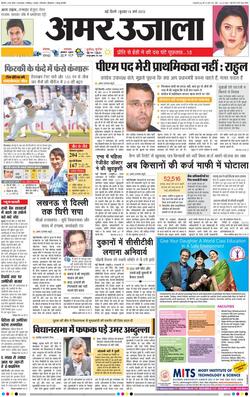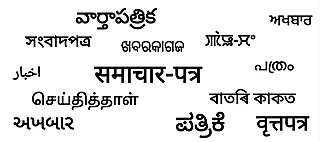Related Research Articles

Bihar is a state in Eastern India. It is the third largest state by population, the 12th largest by area, and the 15th largest by GDP in 2021. Bihar borders Uttar Pradesh to its west, Nepal to the north, the northern part of West Bengal to the east, and Jharkhand to the south. Bihar is split by the river Ganges, which flows from west to east. On 15 November 2000, southern Bihar was ceded to form the new state of Jharkhand. Only 11.27% of the population of Bihar lives in urban areas as per a 2020 report. Additionally, almost 58% of Biharis are below the age of 25, giving Bihar the highest proportion of young people of any Indian state. The official language is Hindi, which shares official status alongside that of Urdu. The main native languages are Maithili, Magahi and Bhojpuri. But there are several other languages being spoken at smaller levels.

Hindūstān is a historical region, polity, and a name for India, historically used to refer to the northern Indian subcontinent, and used in the modern day to refer to the Republic of India. Being the Iranic cognate of the Indic word Sindhu, it originally referred to the land of lower Indus basin during the ancient era, but was later extended to refer to northern Indian subcontinent. It finally referred to the entire subcontinent since the early modern period. Since the Partition of India in 1947, Hindustan continues to be used to the present day as a historic name for the Republic of India.

The Economic Times is an Indian English-language business-focused daily newspaper. It is owned by The Times Group. The Economic Times began publication in 1961. As of 2023, it is the world's second-most widely read English-language business newspaper, after The Wall Street Journal, with a readership of over 900,000. It is published simultaneously from 14 cities: Mumbai, Bangalore, Delhi, Chennai, Kolkata, Lucknow, Hyderabad, Jaipur, Ahmedabad, Nagpur, Chandigarh, Pune, Indore, and Bhopal. Its main content is based on the Indian economy, international finance, share prices, prices of commodities as well as other matters related to finance. This newspaper is published by Bennett, Coleman & Co. Ltd. The founding editor of the paper when it was launched in 1961 was P. S. Hariharan. The current editor of The Economic Times is Bodhisattva Ganguli.

Dainik Jagran is an Indian Hindi-language daily newspaper.
The Biharis or Bihari people are a subgroup of the Indo-Aryans who speak the Bihari languages. Bihari people can be separated into three main Indo-Aryan ethnolinguistic groups, Bhojpuris, Maithils and Magadhis. They are also further divided into a variety of hereditary caste groups. In Bihar today, the Bihari identity is seen as secondary to caste/clan, linguistic and religious identity but nonetheless is a subset of the larger Indian identity. Biharis can be found throughout India, and in the neighbouring countries of Nepal, Pakistan and Bangladesh.
Madhav Vittal Kamath was an Indian journalist and broadcasting executive, and the chairman of Prasar Bharati. He worked as the editor of The Sunday Times for two years from 1967 to 1969, as Washington correspondent for The Times of India from 1969 to 1978 and also as editor of The Illustrated Weekly of India. He had also written numerous books and was conferred with the Padma Bhushan award in 2004. He was born in a brahmin family

Amar Ujala is a Hindi-language daily newspaper published in India which was founded in 1948. It has 22 editions in six states and two union territories covering 180 districts. It has a circulation of around two million copies. The 2019 Indian Readership Survey reported that with 9.65 million it had the 4th-largest daily readership amongst newspapers in India.

Krishna Kumar "Kay Kay" Menon is an Indian actor who works predominantly in Hindi cinema, and few in Gujarati, Tamil, Marathi and Telugu. He is best known for his roles in films such as Black Friday (2004), Deewar (2004), Sarkar (2005), Shaurya (2008), Gulaal (2009), Haider (2014), Baby (2015). He has starred in web series such as Special Ops, Farzi and The Railway Men.
The red corridor, also called the red zone or according to the Naxalite–Maoist parlance the Compact Revolutionary Zone, is the region in the eastern, central and the southern parts of India where the Naxalite–Maoist insurgency has the strongest presence. It has been steadily diminishing in terms of geographical coverage and number of violent incidents, and in 2021 it was confined to 25 "most affected" and 70 "total affected" districts across 10 states in two coal rich, remote, forested hilly clusters in and around Dandakaranya-Chhattisgarh-Odisha region and tri-junction area of Jharkhand-Bihar and-West Bengal.
Hindi is one of the official languages in the Indian state of Bihar. Although Hindustani is the lingua-franca of the region, the majority of the people natively speak one of the Bihari languages.
Aj is a Hindi language daily broadsheet newspaper in India, currently published from 12 cities in the Bihar, Jharkhand, Uttar Pradesh and Uttarakhand states.
Media in Bihar started with Bihar Bandhu, the first Hindi newspaper published there.

Prabhat Khabar is a Hindi-language daily newspaper published in Jharkhand, Bihar and West Bengal, with circulation in some other states in India, including parts of Orissa. It was founded in August 1984 in Ranchi, in Bihar. With the formation of Jharkhand state in November 2000, Ranchi became the capital of Jharkhand. The newspaper is notable for reporting social issues and revealing scams, such as the Fodder Scam, which it began reporting on in 1992. Despite receiving threats, the newspaper wrote 70 reports on the scam and had four or five reporters reporting the story.

Hindi media refers to media in Hindi language and its dialects, across the Hindi belt in India, and elsewhere with the Hindi-speaking Indian diaspora.
Most of the languages of Bihar, the third most populous state of India, belong to the Bihari subgroup of the Indo-Aryan family. Chief among them are Bhojpuri, spoken in the west of the state, Maithili in the north, Magahi in center around capital Patna and in the south of the state. Maithili has official recognition under the Eighth Schedule to the Constitution of India. The official language of Bihar is Modern Standard Hindi, with Standard Urdu serving as a second official language in 15 districts.

The Hans India is an Indian English-language daily newspaper published in the states of Andhra Pradesh and Telangana as well as in New Delhi. The newspaper was started on 15 July 2011 and belongs to Hyderabad Media House Ltd., which also owns Telugu-language news channel HMTV. The chief editor is V. Ramu Sarma.

Angika is an Eastern Indo-Aryan language spoken in some parts of the Indian states of Bihar and Jharkhand, as well as in parts of Nepal.

Maharajadhiraj Sir Kameshwar Singh Goutam Bahadur, K.C.I.E. was the Maharaja of Darbhanga. He held his title over his family estates in the Mithila region from 1929 – 1952, when such titles were abolished following the Independence of India. He had a sister named Lakshmi Daiji.
Sevanti Ninan is an Indian journalist, columnist, researcher and media critic. She is the founding editor of The Hoot, which was the first media watchdog in India. Ninan was the recipient of the Chameli Devi Jain Award for Outstanding Women Mediapersons in 1989, and is a visiting scholar (fellowship) at the Center for the Advanced Study of India, an academic center associated with the University of Pennsylvania.
Rahmatpur is a sizable village situated in the Asarganj Block of the Munger district, Bihar. It also functions as a Gram Panchayat and falls under the jurisdiction of the Asarganj Community Development Block. Positioned in the Ang Pradesh region of Bihar, its closest town is Munger, approximately 50 kilometers away.
References
- ↑ Ninan, Sevanti (2007). Headlines From the Heartland: Reinventing the Hindi Public Sphere By Sevanti Ninan. p. 44. ISBN 9780761935803.
- ↑ "The Indian Newspaper Society". Archived from the original on 13 December 2007. Retrieved 8 January 2008.
- ↑ "South Asian Newspapers in Australian Libraries". Archived from the original on 7 June 2007. Retrieved 11 May 2007.